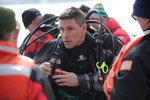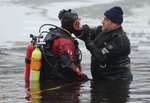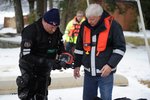SULLIVAN COUNTY, NY — On February 20, a couple of young women riding an almost-new four-wheeler broke through the ice in White Lake during the annual King of the Ice festival.
By all …
Stay informed about your community and support local independent journalism.
Subscribe to The River Reporter today. click here
This item is available in full to subscribers.
Please log in to continueNeed an account?
|



Related
SULLIVAN COUNTY, NY — On February 20, a couple of young women riding an almost-new four-wheeler broke through the ice in White Lake during the annual King of the Ice festival.
By all post-event accounts, the riders narrowly escaped death in the frigid waters of the lake. But they managed to get to shore after struggling in the freezing water. There, with the help of an unidentified Good Samaritan, they were taken to the local firehouse.
Two weeks to the day after the near-fatal accident, members of the Sullivan County Dive & Rescue Team showed up in force at the scene to stage a recovery operation. At the same time, the operation served as a real-time training exercise for the divers and support staff.
That Sunday, the team gathered at the White Lake Fire Department for a pre-operation briefing, during which the trio of assigned divers was given pre-dive medical checkups, while the onshore support staff received detailed instructions.
Dan Tamburro, the father of Amanda, his 25-year-old daughter and the driver of the four-wheeler, was on hand to witness the recovery of the sunken vehicle.
“Amanda and her friend Nicole were out on the ice during the ice fishing contest two weeks ago, and they fell through the ice,” he said. “They went under, my daughter got up on the ice, but fell through again, but was able to pull her friend out.” Luckily someone came along to take the shivering young women to the White Lake Firehouse, he added.
“Thank God for him,” Tamburro said, noting that his daughter and the Good Samaritan now share a common experience. When younger, the man once fell through the ice but lived to tell the harrowing tale.
Several local fire departments, some with their own specialized water rescue squads, as well as EMS teams, were involved in the recovery/training operation: White Lake, Kauneonga Lake, Youngsville, Wurtsboro, Bloomingburg, Neversink, Highland Lake, Narrowsburg and Lava.
Joseph Ratner of the Youngsville Fire Department serves as captain of the Sullivan County Dive & Rescue Team.
He said that the recovery operation was a good training opportunity. “Because if a person was in the water, like when if a motor vehicle went through the ice, we’d know how to get them out.”
Later on, after the vehicle was hauled out, Ratner explained the importance of immediately calling 911 for help in cases where people are submerged in cold water, as the mammalian diving reflex can automatically kick in, allowing rescuers to potentially revive victims after lengthy periods underwater.
What’s the mammalian diving reflex?
It’s a series of physiological responses to immersion that overrides the basic homeostatic reflexes, allowing air-breathing vertebrates—that’s us—to endure submersion for a long time.
“Especially in winter, if somebody goes through the ice and falls to the bottom, there’s a good chance we can recover people who have been submerged,” he said, noting that in water-related emergencies, fire departments must request the dive team through the Sullivan County Emergency 911 Center.
As with most first-responder agencies, “manpower’s always a problem… especially during the week.” Ratner said that the dive team often relies upon mutual aid from other departments with water rescue skills. “We all train together so we’re on the same page.”
The team can request assistance from water rescue units in Ulster County and Orange County in New York State, or Ledgedale and Matamoras in Pennsylvania.
Ratner said the team is trained in vehicle underwater extraction, ice diving and recovery, surface ice rescue and what he called “regular water recovery.”
“I started out on this team even before I learned how to dive, he said.
Warren Wagner, chief of the Highland Lake Fire Department, is a certified rescue diver and serves as co-captain of the dive and rescue team.
While helping to handle safety lines attached to the divers in the water—and at times under the ice—he talked about the specialized techniques and unique hazards related to ice diving, as compared to the dangers of cave diving and the relative safety of open water diving.
“We operate with a minimum of three divers suited up: primary diver, a backup diver and a 90-percent diver, and at least two support people [on shore],” he said, noting that the area has numerous lakes, ponds and rivers, all of which can prove suddenly deadly to the unwary or ill-equipped.
At the conclusion of the recovery/training operation, the four-wheeler, located approximately 105 feet from the shoreline, at a depth of 16 feet with good underwater visibility, was hauled back to dry land by the team. Lifting airbags and brute strength were used, with all hands on deck.
Thomas Davies, a volunteer firefighter and specialty rescue diver with the Youngsville Fire Department, was the primary diver charged with locating the sunken vehicle and attaching the first recovery line.
This was his reaction to the mission, and why he signed up as a volunteer 16 years ago.
“It was very cold. I’m glad we got the four-wheeler out of there, and volunteering helps keep the community together.”
Related stories

Comments
No comments on this item Please log in to comment by clicking here